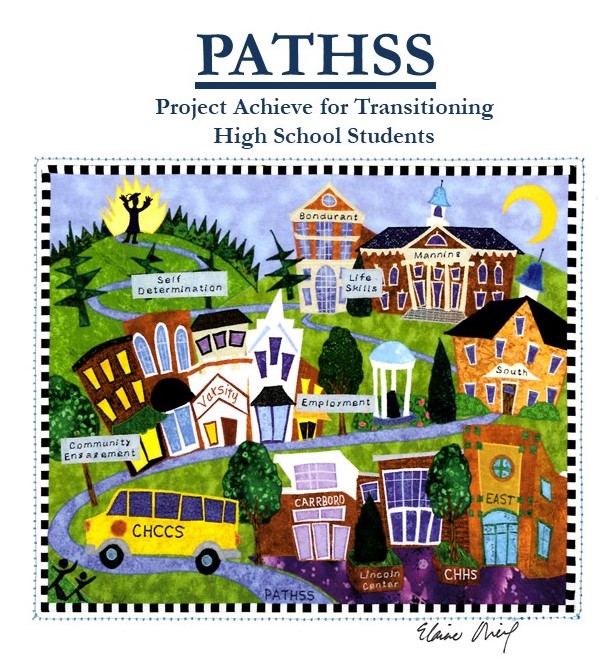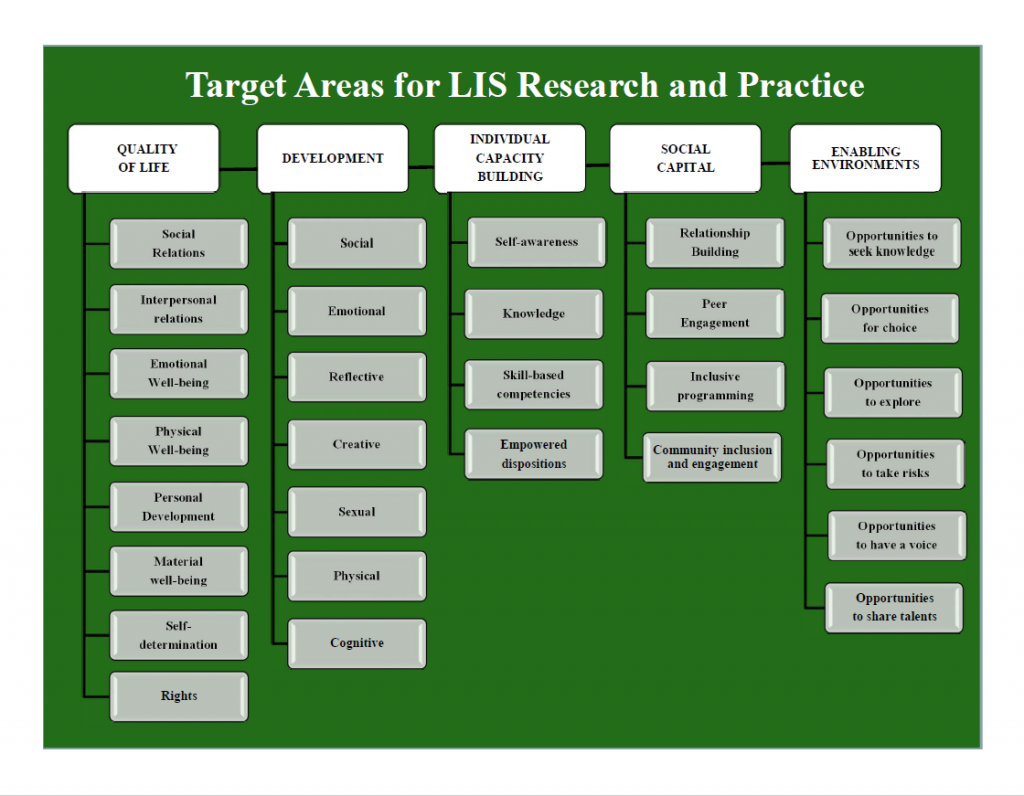DECONSTRUCTING INFORMATION POVERTY
Deconstructing Information Poverty: Identifying, Supporting, and Leveraging Local Expertise in Marginalized Communities is a 3-year project funded through the Laura Bush 21st Century Early Career Grant awarded to Dr. Amelia Gibson, associate professor in the School of Information and Library Science at the University of North Carolina at Chapel Hill. Project partners include Durham County Library, Charlotte Mecklenburg Library, and the Autism Society of North Carolina. Engaging the concept of the library as community anchor, the inquiry employs a mixed methodology to examine (1) the potential for libraries to help people with Autism Spectrum Disorders (ASD) and their families fulfill their information needs and reduce information poverty in local ASD communities, and (2) the potential for members of local ASD communities to act as self-advocates, and take an active role in library programming, planning and collection development. Anticipated outcomes include advancing a model of information poverty and access in the study communities as well as specialized expertise (among librarians/staff and members of the ASD; developing and disseminating an online toolkit for librarians and library staff; and developing and conducting an interactive workshop and webinar to teach practitioners how use the toolkit in a local library or system (including instruction on the theoretical model as a basis for thinking about community needs and outreach).
PATHSS
Fall 2015-Spring 2017
Project Achieve for Transitioning High School Students, also known as PATHSS, was a pilot comprehensive transition program for high school students with intellectual and developmental disabilities (I/DD) located on the campus of UNC-Chapel Hill. PATHSS’ mission was to promote positive adult life outcomes for students with I/DD by equipping them with the essential skills and mindset to fully experience the rights, responsibilities, and benefits of citizenship. This includes meaningful, paid employment in integrated work settings, community access and engagement, and self-determined life management. 
Created to address the lack of community-based vocational training opportunities for students with I/DD, PATHSS emerged through a collaborative partnership between Chapel Hill-Carrboro City Schools and The University of North Carolina at Chapel Hill, spearheaded by Dana Hanson-Baldauf (PATHSS’ Program Coordinator) and Susan Lombardo (CHCCS Transition Specialist). UNC’s Division of Finance and Operations provided PATHSS’ staff administrative support and the School of Information and Library Science donated program space Manning Hall. Faculty and staff from the National Technical Assistance Center on Transition, TEACCH Supported Employment, National Implementation Research Network , UNC’s Division of Occupational Science and Occupational Therapy, and UNC’ Center for Disability and Literacy Studies provided guidance and support throughout program development and implementation.
PATHSS Curriculum emphasized four critical areas of transition: employment, daily living skills, community access, and self-determination. Externships with campus employers presented opportunities for students to engage in authentic work tasks in real work environments. Externship sites included Davis Library (Circulation Department), Carolina Dining Services, Human Resources (Facilities), Student Stores (Warehouse), the Department of Geological Sciences, the Office of Undergraduate Education, the Athletics Department (Facilities), and Information Technology Services. Through the course of the school year, students rotated through six to eight half-day externship, Monday through Friday, 8-16 weeks each. PATHSS’ job coaches provided students onsite supervision and training support. Through externships, PATHSS students were able to gain greater insight into the world of work, build marketable skills, establish meaningful connections across campus, and develop a greater awareness of and appreciation for their individual strengths, talents, and capabilities.
Beyond employment, PATHSS’ learning objectives and programming were designed to enable students with the necessary life skills, self-agency, and resilience to build and direct lives of their own choosing. Instruction and learning activities centered on individual student goals, motivations, and interests. Partnership with UNC’s Division of Occupational Science and Occupational Therapy enabled mutually beneficial opportunities for OT graduate students and PATHSS students to work and learn together with focus on daily life skills including meal preparation, home management, and self-care. Officers with UNC’s Public Safety met regularly with PATHSS students and provided sessions on personal safety in the home and community. Regular trips off campus enabled students learn about and practice using public transportation, navigating the community, consumer and banking skills, and accessing community resources. UNC Best Buddies provided peer mentorship and meaningful opportunities for friendship.
Of the eight students who participated in PATHSS’ pilot program, one student transitioned into a post-secondary education program, one student continues vocational training through a local support agency, and six students are competitively employed in integrated work settings.
EMPLOYER PERSPECTIVES ON INTEGRATED EMPLOYMENT
Employer Perspectives on the Integrated Employment of Individuals with Intellectual and Developmental Disabilities was research grant awarded by the SHRM Foundation to Dana Hanson-Baldauf and Meredith Weiss. This study addresses the high unemployment rate of individuals with intellectual/developmental disabilities and a gap in the research literature on successful integrated employment practices from the perspectives of employers who hire and retain workers with I/DD. The following three questions guided the inquiry: R1. How individuals are employed? R2. what factors that contribute to their employment and retention? and R3. what is the perceived impact of their inclusion on the employing organization? Investigators conducted semi-structured interviews and administered a follow-up survey to sixteen employers from employment settings diverse in size and business type.
R1. Six categories of employment were identified:
| clerical/fulfillment services | copy and mail room clerks |
|---|---|
| technical services | microfilm and imaging technicians |
| research | lab technicians |
| healthcare/hospitality | room service attendant, dishwasher, linen support |
| food service | cooks, dishwashers, bussers, server supports |
| grocery/retail | stockers, cashier assistants, baggers, cart attendants, bakery assistants produce clerks |
R2. Factors that contributed to successful employment experiences included:
Good “fit” between employee (skills and disposition) and the employer (workforce needs and work climate)
Management Style reflecting the following qualities: calm, creative, flexible, patience, reflective, empathic, risk-taking, values diversity, strengths-focused, and direct communication
Supportive work climate fostering natural supports, a sense of community, and collaborative
Third-party support, for instance, supported employment staff and family
Workplace accommodations including visual/process-oriented supports, communication and work logs, procedural flexibility, space
R3. The following statements highlight the most frequently expressed observations by participants. Employees with I/DD:
• bring unique and exceptional strengths and skills to the workplace
• are highly dependable demonstrating positive work habits – punctuality, low absenteeism, and consistent work performance
• are hardworking and productive
• are conscientious and responsible
• enhance the work climate and positively influence coworkers
• contribute to a stable workforce
• positively enhance an organization’s public image
Study findings support the growing body of evidence that individuals with I/DD can and do bring value to today’s labor market in diverse and meaningful ways, particularly when employed with appropriate and personalized supports and accommodations. In light of these findings, an integrated employment model of “good fit” is proposed outlining four critical and interdependent variables: the commitment of an employer, individual readiness for employment, a strong support network, and an enabling work environment. Implications for HR professionals, including considerations and strategies, are provided in the research document.
Model of “Good Fit” in Support of the Integrated Employment of Individuals with Intellectual/Developmental Disabilities
Hanson-Baldauf, D., Weiss, M., & Bunch, T. (2014). Employer perspectives on the successful employment and retention of workers with intellectual and developmental disabilities. SHRM Foundation. [PDF]
EXPLORING THE EVERYDAY LIFE INFORMATION NEEDS, PRACTICES, AND CHALLENGES OF EMERGING ADULTS WITH INTELLECTUAL AND DEVELOPMENTAL DISABILITIES
Exploring the Everyday Life Information Needs, Practices, and Challenges of Emerging Adults with Intellectual and Developmental Disabilities addresses a gap in the library and information science literature on everyday life information (ELI) needs and experiences of emerging adults with intellectual disabilities (I/DD). Emerging adulthood refers to the period between the late teen years and mid-twenties. Although this is a period of significant change for all young people, for individuals with I/DD this life stage is recognized as one of the most stressful times of life. The challenges experienced by these individuals suggest considerable areas of information need. This case study research explored the ELI needs, practices, and challenges of four emerging adults with I/DD. Employing a participatory research approach, participants played a central role in the inquiry process by offering time, input, and invitations into their daily lives for observation and study. Data collection methods included semi-structured interviews, participant/non-participant observations, artwork, photography, and document review of IEP and PCP reports. Analyses revealed four rich and multifaceted lives led by individuals exhibiting a wide range of both formidable and whimsical ELI needs. Twenty-nine categories of ELI need were identified, including multiple subcategories. All four participants displayed high motivation and great initiative in their ELI practice as information seekers, consumers, producers, managers, and providers. They also employed a wide range of tools, resources, and strategies to their advantage, despite considerable challenges – inherent and imposed. Barriers inhibiting information access were identified under the
following categories: intrapersonal, physical, economic, social, and institutional. Results from this study parallel findings from other youth-ELI studies. The need for cognitively accessible information and proactive LIS service was underscored in each case study as a necessary mean toward supporting the developmental processes of emerging adults with I/DD and the development of knowledge, skills, and dispositions for self-actualization and enhanced adult life outcomes. A person-centered, outcomes-oriented model for LIS research and practice is proposed with emphasis on a strengths-based approach that capitalizes on individual capabilities, interests, and life priorities in recognition of the whole person. Five target areas are identified for LIS attention: individual capacity building, social capital, developmental processes, quality of life, and enabling environments.
Everyday Life Information Model in Support of
Emerging Adults with Intellectual/Developmental Disabilities
Target Areas for LIS Research and Practice in Support of
Emerging Adults with Intellectual/Developmental Disabilities
Hanson-Baldauf, D. (2013). Exploring the everyday life information needs, practices, and challenges of emerging adults with intellectual disabilities (Doctoral dissertation, The University of North Carolina at Chapel Hill). [PDF]


